
The day machine learning tried to punt a profitable strategy — and what it reveals about human insight vs. algorithmic advice
I fed a client’s marketing data into an AI analysis tool last week.
The verdict was swift and confident: “Stop running social media ads immediately. Zero ROI.”
The algorithm was dead wrong.
See, the AI was looking at Google Analytics attribution, which showed Meta ad campaigns driving almost no sales.
Case closed, right?
But something felt off.
I dug deeper into our social platform and Shopify tracking and found dozens of conversion events the AI had missed. Our social ad campaigns were clearly profitable.
Then I spotted the real pattern.
Users were discovering the product on mobile through social ads (where most are seen), then switching to desktop to complete purchases.
Google Analytics labeled these sales as “direct” traffic instead of social conversions.
The AI missed the human behavior that mattered most.
People browse social media on phones but buy on computers. Especially for higher-ticket products where they want bigger screens for easier research and a keyboard for checkout.
The algorithm saw data points.
Human reasoning saw customer behavior.
This happens constantly with AI tools. They optimize for what they can measure, not what actually drives business results.
They have no true human experience.
Machine learning is incredibly powerful for pattern recognition in clean data.
But marketing is messy. Customers do NOT follow linear paths from impression to purchase.
They research on Instagram, discuss with friends, compare options, then buy three days later on a different device through a different channel.
AI can’t read between those lines yet.
It can’t understand how your “low-performing” awareness campaign actually seeds trust for future purchases.
Or that customers who engage with your content on social become higher-value buyers through other channels.
The strategic approach: Use AI for data processing, not decision making.
Let algorithms surface patterns you might miss in massive datasets.
But always overlay human judgment that understands customer psychology, cross-channel behavior, and business context.
The most dangerous phrase in marketing right now? “The AI recommended it.”
Whether it’s an ad campaign or your go-to-market strategy, you need human expertise, creativity and insights.
What’s the worst algorithmic advice you’ve almost followed?
Forward this to someone using AI for marketing decisions, or reach out to my intuitive team of product marketing strategists at Graphos Product.
